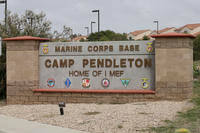Even after 28,000 hours of flight time in Iraq and Afghanistan, the MV-22 Osprey tilt-rotor aircraft had to undergo yet another test flight today to prove its safety and reliability to the Japanese and bolster U.S. strategic planning for the Pacific.
"I will check on the (Osprey) noise and how stable it is," Japanese Defense Minister Satoshi Morimoto said of his two 35-mile demonstration flights on an MV-22 from the Pentagon helipad to the Marine base at Quantico, Va., and back after meetings with Defense Secretary Leon Panetta.
Morimoto, who has been seeking to ease the safety concerns of a Japanese public deeply mistrustful government assurances, also told the Kyodo news service that he would "ask the United States to swiftly provide (more) information" on recent Osprey accidents before he would recommend allowing flight operations for the MV-22s at the Marines’ Futenma Air Station on Okinawa.
The Osprey with Morimoto aboard hopped off the helipad into clear skies and flew low on a northward route along the Potomac near the Washington Monument and then gently banked left to turn south for Quantico, all in helicopter mode to comply with restrictions for flying in and around the District.
Reporters aboard the Osprey said that the pilots from the VM266 squadron in New River, N.C., then tilted the rotors to airplane mode for most of the quick trip to Quantico, where Morimoto received more technical briefings on the MV-22. Morimoto seemed animated and appeared to be enjoying his first Osprey experience, the reporters said.
The Ospreys that were offloaded in Japan last week are currently grounded. Earlier, at a Pentagon news conference packed with Japanese press, and military and government officials, Morimoto and Panetta both said that Osprey flights from Okinawa would not go forward until reports on the recent accidents had been received and vetted by Japanese technicians.
But both also suggested that flight operations by the MV-22s on Okinawa would likely begin on schedule in late October once due diligence for the concerns of the Japanese public had been shown.
And both Panetta and Morimoto spoke in terms of "when" rather than whether the Ospreys would fly.
Morimoto said there was agreement that the two countries would corrdinate on how the Ospreys operate. "When the Osprey is operated in Japan, all the relevant issues will be discussed in a Japan-U.S. joint committee meeting. And in order to solve these problems, we are actively cooperating and (will) give utmost consideration to ensure the safety of the local population," Morimoto said.
Panetta, who jokingly refers to the innovative aircraft as "the gizmo," said the Ospreys had a major role in the U.S. strategic shift to the Asia-Pacific, and he expected a quick decision to allow the 12 Ospreys that arrived by ship in Iwakuni, Japan, earlier this month to be moved to Futenma.
His discussions with Morimoto focused on the U.S. buildup in the region, Panetta said, and "A key part of that force posture is the deployment of Marine Corps MV-22 Ospreys to Okinawa."
"The Osprey is a critical aircraft that is flying operations around the world, on the front lines in Afghanistan as well as around communities here in the United States," Panetta said.
"The Osprey is important to the defense of Japan. It will enable Marines to fly faster and farther from Okinawa to remote islands in Japan. And with the ability to refuel in flight, it can stay aloft much longer. This is a one-of-a-kind platform," Panetta said.
The Marines maintain that the MV-22's accident rate is less than the average for all aircraft operated by Corps, but plans for the Osprey deployment were thrown into doubt by a string of accidents.
The Japanese raised objections after the crash of an MV-22 in April during a training exercise in Morocco that killed two Marines and another crash in June by a CV-22, the Air Force variant, in Florida that injured five. Then on July 9, an MV-22 had to make an emergency landing at the Wilmington International Airport in North Carolina, further rattling the Japanese.
After a meeting with Morimoto last week, Okinawa Gov.Hirokazu Nakaima said "If the United States forces through the Osprey deployment in Okinawa and an accident or other incident occurs, we will have no choice but to seek an immediate shutdown of all military bases."
Mayor Atsushi Sakima of Ginowan, home to the Futenma base, said "It is very regrettable and unacceptable" that the Ospreys would be based there. "It’s an undeniable fact that Ospreys crashed twice in as many months," Kyodo reported.
China, which has opposed the U.S. Pacific "pivot," has seized on the issue to criticize the strategic shift as poorly conceived and unnecessary, and has used its official media to mock the "accident-prone Osprey" as a prime example of wrongheaded U.S. policy.
At a media roundtable in Tokyo last week, Deputy Defense Secretary defended the Osprey against a barrage of skeptical questions from Japanese reporters.
Carter insisted that "We've agreed on a path ahead. And I absolutely understand the concerns of the Japanese people for flight safety, because I share their concerns fori flight safety. I don't have any problem with that at all. These are serious technical issues; they'll be resolved."





























